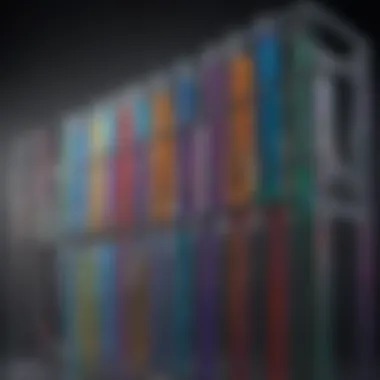The Integral Role of Test Tubes in Scientific Research


Intro
Test tubes are a fundamental tool in the laboratory. Their role cannot be overstated when it comes to conducting scientific research. This article explores how test tubes aid in experiments, their materials, and design variations. The evolution of test tubes from simple glass containers to specialized instruments plays a significant part in enhancing the accuracy and safety of scientific investigations.
In chemical and biological research, test tubes provide a controlled environment. They enable scientists to mix, heat, and react various substances. Using test tubes helps minimize contamination and allows researchers to isolate variables effectively. This is critical for drawing valid conclusions.
The focus on test tubes reflects a larger trend in scientific research. Researchers emphasize the importance of precision and safety in laboratory settings. The aim is to improve reliability and reproducibility of experiments. This article delves into these aspects, signifying the relevance of test tubes to modern science.
Key Research Findings
Overview of Recent Discoveries
Recent studies uncover vital insights regarding the design and material innovations used in test tubes. For instance, the emergence of borosilicate glass offers higher resistance to thermal shock compared to traditional glass. This advancement is particularly important in fields such as chemistry where temperature variations are common. Researchers emphasize the use of high-quality materials to prevent reactions between test tubes and chemical substances. Furthermore, some recent models include integrated features that enhance usability.
Significance of Findings in the Field
The findings on test tube development have broad implications. In biology, the ability to conduct accurate assays is crucial. Improved materials ensure that there is no leaching of compounds that may interfere with results. An example is the material used in blood tests, where contamination can lead to incorrect diagnoses. Innovations in test tube design also facilitate better mixing and heating, which contribute to more reliable results.
"The evolution of test tubes represents a greater movement towards standardization and precision in laboratory practices."
The enhancements in test tube technology not only advance research quality but also promote safety measurements. As laboratories increasingly prioritize safety protocols, understanding the role of equipment like test tubes helps create a more secure working environment.
Finale
In summary, the essential role of test tubes in scientific research is multi-faceted. They allow for precise experimentation, support safety protocols, and continue to evolve with advancements in materials and design. By delving deeper into their significance, researchers lay the groundwork for future innovations that may further influence the scientific domain.
Foreword to Test Tubes
Test tubes are fundamental tools in various scientific realms, notably chemistry and biology. They allow for the observation and experimentation of chemical reactions and biological processes in a controlled environment. Understanding the role of test tubes in scientific research is crucial. They provide essential benefits that enhance experimental accuracy and reliability. Without test tubes, many laboratory protocols would be challenging to execute.
Historical Context
The use of test tubes dates back several centuries. Initially, they were made from metal or clay. Their development paralleled advancements in glass making. The invention of glass test tubes in the 19th century marked a significant turning point. Scientists could conduct experiments with clear visibility. This transparency is vital for studying reactions. Over time, materials used for test tubes evolved. Manufacturers began to create standardized sizes and shapes.
Definition and Purpose
A test tube is a cylindrical container, typically made of glass or plastic. It has an open top and a rounded bottom. The primary purpose of a test tube is to hold small amounts of substances for experimentation. They are essential for conducting chemical reactions, preparing solutions, and other laboratory activities. Test tubes are designed to withstand temperature variations. This makes them suitable for both heating and cooling processes. Additionally, their compact size makes them convenient for handling and storage in laboratory settings.
Test tubes are crucial as they serve multiple purposes:
- Mixing substances
- Heating samples
- Observing reactions
- Conducting quantitative and qualitative analysis
Test tubes symbolize the advancement of scientific methodology, enabling precision and improvement in experimentation.
Material Composition of Test Tubes
The material composition of test tubes is fundamental to their performance in laboratory environments. Different materials exhibit unique properties that are crucial for various applications in scientific research. Understanding the composition helps in selecting the appropriate type of test tube for specific experimental conditions. Key materials used include glass and plastic, each with its own set of advantages and disadvantages.
Glass Test Tubes
Types of Glass
Various types of glass are used in the manufacturing of test tubes, each with distinct characteristics that influence their utility in scientific experimentation. The most common types are borosilicate glass and soda-lime glass. Borosilicate glass is preferred because of its exceptional thermal resistance and durability. This glass can withstand high temperatures and rapid temperature changes without breaking. In contrast, soda-lime glass is less expensive but has lower thermal resistance.
The choice of glass impacts the overall functionality of test tubes. For instance, borosilicate glass is especially beneficial in chemistry labs where reactions can produce significant heat. The unique feature of borosilicate glass, also, is its low coefficient of thermal expansion. This reduces the risk of thermal stress, making it a popular choice despite its higher cost.
Temperature Resistance


Temperature resistance is a critical consideration when selecting test tubes. Borosilicate glass tubes can typically resist temperatures of up to 500 degrees Celsius. This feature allows them to be used in high-temperature experimental conditions like boiling liquids or autoclaving sterilization. The high resistance quality also contributes to the reliability of results, as experiments are less likely to be compromised by the glass breaking or deforming under heat.
Despite the advantages, glass test tubes can be fragile. They are prone to breakage if mishandled or subjected to an abrupt temperature change, which is a significant disadvantage, especially in busy laboratory settings.
Plastic Test Tubes
Benefits of Plastic
Plastic test tubes are made from materials such as polypropylene or polystyrene. They are lightweight and unbreakable, making them safer to handle than glass tubes. The main benefit of using plastic test tubes lies in their cost-effectiveness. They tend to be significantly cheaper than glass alternatives, which can be an important factor, especially for educational institutions and research facilities with budget constraints.
Another advantage of plastic tubes is their versatility. They are available in various sizes and can be used for a wide range of applications, including biological and chemical experiments. Additionally, some types of plastic test tubes are designed to be sterile, which ensures their safety for use in biological experiments or clinical studies. Overall, plastic test tubes contribute to cost savings and flexibility in various scientific applications.
Disadvantages of Plastic
While plastic test tubes offer many benefits, there are also notable disadvantages. One key concern is their chemical resistance. Certain chemicals can cause plastic to degrade or leach harmful substances into solutions, impacting experimental integrity. Furthermore, plastic test tubes do not have the same heat resistance as glass, limiting their use in high-temperature scenarios. They can warp or melt at elevated temperatures.
As a result, it is essential for researchers to consider the specific requirements of their experiments when choosing between glass and plastic test tubes. Each material has unique properties that can affect the research outcomes, and understanding these differences is vital.
"Choosing the right material for test tubes is crucial for the accuracy and safety of scientific research."
Design Features of Test Tubes
The design features of test tubes play a crucial role in their functionality and application within scientific research. Test tubes come in various shapes, sizes, and gradations, each tailored for specific experiments and reactions. Understanding these design characteristics contributes significantly to the accuracy and effectiveness of laboratory processes. For students, researchers, and professionals, knowledge of these design elements is essential as they often determine the usability of test tubes in various experimental setups.
Shape and Size Variations
Test tubes can be found in a wide range of shapes and sizes. Typically, the most common shapes are straight and tapered. The straight design allows for easier mixing and maneuverability, while the tapered shape contributes to better control during pouring and transfer of liquids. Common sizes vary from 10 mL to 100 mL, but specialized sizes can also be found. This diversity allows scientists to select the appropriate test tube for the specific volume of the substance being analyzed, preventing waste and ensuring accurate measurements.
Another aspect of shape and size variations is the thickness of the glass or plastic. Thicker materials provide better thermal stability, while thinner ones can be more lightweight and easier to handle. Ultimately, the choice of shape and size can help in optimizing experimental setup and achieving desired results without introducing unnecessary variables.
Graduated Test Tubes
Graduated test tubes are designed with measurement markings along the side, making them vital for precise volume measurement. These markings are often in milliliters, allowing for easy and quick readings against the volume of liquid inside. Graduated test tubes are indispensable in experiments where accurate measurements are critical, such as titrations or dilution procedures.
The scale markings must be clear and easy to read for effective use. Moreover, the accuracy and precision of these measurements may depend on the user's ability to read the meniscus level correctly. This aspect emphasizes the importance of careful handling when working with graduated test tubes.
Graduated test tubes enhance the capacity for precise scientific measurements, which is essential for replicable results in research.
In laboratory applications, the design features of test tubes, including shape, size, and graduated markings, all contribute to their fundamental role in supporting scientific inquiry and advancing experimental practices. Understanding these features helps in selecting the right type of test tube for the task at hand, leading to more reliable and accurate research outcomes.
Applications of Test Tubes in Scientific Research
Test tubes serve essential roles in scientific research across various fields. Their versatility allows for a wide range of applications, each contributing significantly to the accuracy and reliability of experimental outcomes. Test tubes enable precise manipulation of substances, providing a controlled environment that fosters both chemical and biological interactions. Understanding these applications can greatly enhance our appreciation for their role in advancing scientific knowledge.
Chemical Reactions
Chemical reactions are fundamental processes in science, and test tubes facilitate many of them. The design of test tubes allows for easy mixing, heating or cooling, and observation of reactions. The materials of test tubes, whether glass or plastic, resist chemical attacks from reactants, ensuring validity in experimental results. Furthermore, the compact nature of test tubes promotes efficient use of materials, which is especially important in research where reagents can be scarce or costly.
Biological Experiments
Biological experiments encompass a broad spectrum of research areas, including cell biology, enzymology, and microbiology. Test tubes are vital in creating conditions necessary for observing biological phenomena.
Cell Cultivations
Cell cultivations often use test tubes to grow and maintain cell lines. This method provides a controlled space that allows for specific environmental adjustments. One key characteristic of using test tubes is the ease of scaling up experiments, as multiple cultivations can occur simultaneously. Test tubes also enable precise control of variables such as temperature, pH, and nutrient concentration, making them a beneficial choice for researchers. However, limited surface area can restrict growth in some cases, so researchers must consider this factor when planning experiments.
Enzyme Reactions


Enzyme reactions, crucial for understanding metabolic pathways, frequently utilize test tubes for experimentation. The design allows for convenient mixing of substrates and enzymes, which is essential for accurate kinetic studies. A critical aspect of using test tubes in enzyme reactions is the ability to monitor progress through sampling at various time points. This characteristic is beneficial for research that requires precise enzymatic activity assessments. Nevertheless, researchers must be mindful of volume constraints, which may limit the scale of certain experiments.
Testing and Analysis
Testing and analysis play significant roles in various scientific disciplines, often demanding stringent conditions to ensure data accuracy. Test tubes support various analytical techniques, such as spectrophotometry and chromatography.
Spectrophotometry
Spectrophotometry is a method that measures the amount of light absorbed by a solution, making it crucial in biochemical analysis. Test tubes provide a consistent geometry for sample presentation, aiding in reproducibility. One of the advantages of using test tubes in this context is their compatibility with various wavelengths, which is vital for diverse types of analyses. However, proper selection of test tube material is essential, as certain plastics may absorb specific wavelengths, affecting data accuracy.
Chromatography
Chromatography separates components of a mixture based on their interactions with stationary and mobile phases. Test tubes are used primarily for sample collection or as containers for solid-phase extraction. Their design aids in preventing contamination and loss of sample integrity, which is crucial in analytical chemistry. A notable feature of chromatography utilizing test tubes is the ability to analyze multiple samples simultaneously, enhancing overall productivity. Despite their advantages, researchers may face challenges in scalability when adapting protocols from small test tube sizes to larger volumes.
Safety Considerations When Using Test Tubes
Understanding the safety considerations when using test tubes is paramount for successful laboratory operations. Test tubes are essential tools in scientific research, but improper handling and maintenance can lead to accidents and contamination. Recognizing these safety practices minimizes risks and ensures that research is conducted with precision and reliability.
Proper Handling Techniques
When working with test tubes, handling them safely is crucial. Firstly, always use a test tube holder or tongs to avoid direct contact. This method reduces the risk of breaking the glass or causing injury due to heat or chemical exposure. Second, avoid carrying multiple test tubes at once. This practice decreases the chance of accidents, such as dropping or colliding, which can result in spills or injuries.
Next, when pouring substances into a test tube, do it slowly and from a safe distance. This limits splashing. If heated solutions are involved, ensure to point the open end away from yourself and others. Always label test tubes clearly to prevent mix-ups and exposure to hazardous materials.
It’s also important to be aware of your surroundings. Make sure workspaces are organized and free from clutter. Familiarity with the layout of the lab can aid quick responses to emergencies.
Cleaning and Sterilization
Cleaning and sterilization are critical steps in ensuring test tubes' usability and safety. After each use, test tubes should be rinsed with water and detergent immediately. For thorough cleaning, using a brush designed for test tubes can be effective in reaching into tight spaces.
To sterilize, several methods can be employed:
- Autoclaving: This is a common technique that uses high-pressure steam to kill microorganisms. Test tubes made from heat-resistant glass are compatible with this method.
- Chemical Sterilization: For plastics or heat-sensitive materials, chemical solutions such as ethanol or bleach can be effective. Rinse thoroughly after sterilization to remove any chemical residues.
- Dry heat: This method is useful for metal or glass test tubes that can withstand high temperatures, but it requires longer exposure times compared to autoclaving.
In addition to these methods, it is important to inspect test tubes regularly for cracks or defects. Damaged test tubes may not only fail during experiments but can also compromise safety. Safe and clean handling of test tubes preserves the integrity of scientific research and enhances the overall reliability of experimental results.
"Proper care and safety measures significantly impact the outcome of laboratory experiments, thus underscoring their relevance in the scientific community."
The Evolution of Test Tube Technology
Test tube technology has seen considerable advancements since its inception. Over the years, these developments have not only improved the efficacy of experiments but have also played a crucial role in expanding our understanding of science. The evolution is marked by innovative materials and the introduction of smart features, both of which enhance accuracy and usability in scientific research.
Innovative Materials
The emergence of new materials has fundamentally altered the landscape of test tube production. Traditionally, glass was the material of choice due to its chemical resistance and clarity. However, modern advances have led to the use of alternative materials like borosilicate glass and various types of plastics. Borosilicate glass offers better thermal resistance, making it ideal for high-temperature experiments. On the other hand, plastic test tubes, while more affordable, have come to be appreciated for their lightweight nature and shatter resistance.
This diversification of materials provides researchers with options tailored to the specific needs of their experiments. For instance, the flexibility and strength of plastic test tubes reduce the risk of breakage, which is critical in busy laboratory environments.
Smart Test Tubes
The introduction of smart test tubes marks a pivotal moment in laboratory techniques.
Integration of Sensors
Smart test tubes often feature integrated sensors that provide real-time data about the conditions within the tube. These sensors are capable of monitoring temperature, pH levels, and even concentrations of specific substances. The key characteristic of this technology is its immediacy; scientists can observe reactions as they happen rather than relying solely on periodic sample checks. This ease of use makes it a valuable asset in time-sensitive experiments. The main advantage is the reduction in human error during observations, enhancing the reliability of results. However, the cost and complexity of such test tubes can be drawbacks, especially in resource-limited settings.
Monitoring Chemical Reactions


Monitoring chemical reactions through smart test tubes can also provide insights into reaction kinetics and product formation. They can automatically log data, allowing for better analysis of processes that happen quickly. This feature is particularly useful in research that requires precise adjustments during experiments. Hence, the key benefit lies in the automation of data collection. While this reduces the manual workload, it may necessitate additional training for laboratory personnel to interpret and act on the collected data effectively.
"The evolution of test tube technology illustrates how innovation addresses both the functional requirements and the complexities of modern scientific research."
Scientific research continues to benefit from these advancements, pushing the boundaries of what is possible in laboratories. Each iteration of test tube technology brings us closer to efficient and accurate experimentation.
Test Tubes in Education
In the realm of education, test tubes hold a pivotal role, particularly in science curricula. They serve as fundamental tools for students to explore various scientific concepts, enhancing hands-on learning and practical understanding. By engaging with these laboratory instruments, students cultivate essential skills that extend beyond mere theoretical knowledge.
Laboratory Teaching Tools
Test tubes act as effective laboratory teaching tools across various academic levels. They enable students to observe chemical reactions, measure liquids accurately, and study organic materials. When students handle test tubes, they develop important techniques, such as pipetting, mixing, and diluting. This exposure fosters a deeper comprehension of the scientific method, as learners design experiments and analyze results.
Moreover, engaging with test tubes teaches safety protocols. Students learn how to handle glass and plastic materials properly, which is critical in a laboratory setting. It instills a sense of responsibility and care for the experiments they conduct. Educational institutions often create laboratory simulations using test tubes to replicate real-world scenarios, allowing students to appreciate their significance in research.
Practical Application in Curricula
Incorporating test tubes into science curricula has clear practical applications. Their use facilitates a more interactive learning environment. Students can participate in experiments that illustrate key principles of chemistry and biology. This hands-on learning approach helps clarify complex concepts and provides a tangible experience to abstract theories.
For instance, in chemistry classes, students can conduct titrations using graduated test tubes. This practice not only teaches them about concentration calculations but also enhances their analytical thinking. In biology, test tubes assist in experiments involving enzyme reactions and cell cultivations.
Teachers can align test tube experiments with educational objectives, ensuring that practical applications support the theoretical framework. Projects and experiments related to environmental science, such as testing water samples for pollutants, illustrate real-life issues and promote critical thinking.
"Understanding the hands-on application of test tubes in education prepares students for future scientific inquiries and research activities."
In essence, test tubes are more than mere containers; they are instruments of discovery that play an essential role in fostering scientific literacy and curiosity in students.
Future Directions for Test Tube Use
In the dynamic arena of scientific research, test tubes continue to evolve, adapting to new demands and discoveries. The future usage of test tubes is paramount not only in enhancing experimental accuracy but also in addressing broader concerns such as sustainability and integration of technology in laboratories. Understanding these directions may reveal the benefits and considerations for various stakeholders including researchers, educators, and students.
Sustainability Efforts
One of the critical concerns today is environmental impact. Test tube manufacturers are exploring sustainable materials to reduce waste and chemical footprint. Biodegradable plastics, for instance, are being tested as alternatives to conventional plastics. This move to sustainable materials is vital for minimizing the ecological consequences of disposable labware.
Moreover, recycling programs can also be instituted to handle glass and plastic used in laboratories. By implementing these practices, laboratories can contribute actively to global sustainability efforts while maintaining operational efficiency.
Considering the longevity and disposal of test tubes, redesigning packaging and usage methods is essential. Reusing glass test tubes for multiple experiments can conserve resources, while providing standardized cleaning practices can enhance their lifespan. Initiatives like these not only benefit the environment but promote economical practices in research.
Potential Breakthroughs
As technology advances, so do the possibilities for test tubes. Innovative designs that incorporate smart sensors are emerging. Such test tubes can monitor parameters like temperature and pH levels in real-time. This development supports more accurate data collection during experiments, leading to reliable results.
Furthermore, there is the potential for automation in laboratories. Automated test tube handling systems can streamline workflows, minimizing human error. This increase in efficiency allows researchers to focus on analysis rather than manual tasks.
"The future of test tubes is not just in their materials but in how they can become integral parts of smart laboratory solutions."
The End
The conclusion of this article underscores the multifaceted role that test tubes play in scientific research. Their significance extends beyond mere containers for samples; they are essential instruments that ensure the integrity and reliability of experiments. Test tubes facilitate accurate measurements and observations, playing a pivotal role in various scientific disciplines.
Summary of Key Points
The discussion highlighted several key aspects regarding test tubes, including:
- Material Composition: Test tubes are primarily made from glass or plastic, with each material offering distinct advantages depending on the intended application. Glass test tubes provide excellent thermal resistance while plastic ones are lightweight and shatterproof.
- Design Features: Variations in shape and size allow researchers to choose the right test tube for specific experiments. Graduated test tubes assist in precise measurement.
- Applications: The versatility of test tubes in chemical reactions, biological experiments, and methods like spectrophotometry reflects their integral function in research and analysis.
- Safety Considerations: Proper handling and cleaning protocols are crucial to maintain laboratory safety and the reliability of experiments.
- Future Directions: Innovations in sustainable materials and smart technologies signal a promising future for test tubes.
The Ongoing Relevance of Test Tubes
Test tubes continue to be relevant in modern scientific research despite the advent of advanced technologies. Their simple design and functionality ensure that they meet the essential needs of scientists while adapting to new challenges. The evolution of materials and the introduction of smart features exemplify their ongoing adaptation.
"The simplicity of test tubes belies their critical importance in experimental accuracy and research advancement."
In educational settings, test tubes remain fundamental tools for hands-on learning, cementing their status as indispensable in science curricula. The ongoing research into improving test tube technology showcases a commitment to enhancing experimental practices while maintaining safety and efficacy.















